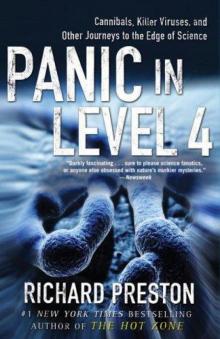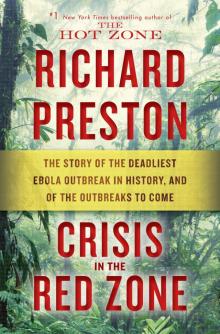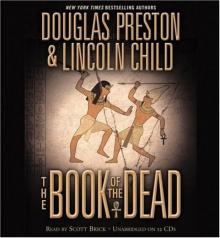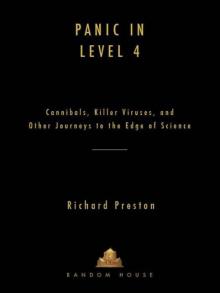- Home
- Richard Preston
Panic in Level 4
Panic in Level 4 Read online
Panic in Level 4
Richard Preston
Bizarre illnesses and plagues that kill people in the most unspeakable ways. Obsessive and inspired efforts by scientists to solve mysteries and save lives. From The Hot Zone to The Demon in the Freezer and beyond, Richard Preston’s bestselling works have mesmerized readers everywhere by showing them strange worlds of nature they never dreamed of.
Panic in Level 4 is a grand tour through the eerie and unforgettable universe of Richard Preston, filled with incredible characters and mysteries that refuse to leave one’s mind. Here are dramatic true stories from this acclaimed and award-winning author, including:
• The phenomenon of “self-cannibals,” who suffer from a rare genetic condition caused by one wrong letter in their DNA that forces them to compulsively chew their own flesh–and why everyone may have a touch of this disease.
• The search for the unknown host of Ebola virus, an organism hidden somewhere in African rain forests, where the disease finds its way into the human species, causing outbreaks of unparalleled horror.
• The brilliant Russian brothers—“one mathematician divided between two bodies”—who built a supercomputer in their apartment from mail-order parts in an attempt to find hidden order in the number pi (π).
In fascinating, intimate, and exhilarating detail, Richard Preston portrays the frightening forces and constructive discoveries that are currently roiling and reordering our world, once again proving himself a master of the nonfiction narrative and, as noted in The Washington Post, “a science writer with an uncommon gift for turning complex biology into riveting page-turners.”
Richard Preston
PANIC IN LEVEL 4
Cannibals, Killer Viruses, and Other Journeys to the Edge of Science
To my father,
Jerome Preston, Jr.
Considering the marvelous adventures
you took me on and sent me on,
this book seems inevitable.
Introduction: Adventures in Nonfiction Writing
OLIVER HEAVISIDE, the English mathematician and physicist, once said, “In order to know soup, it is not necessary to climb into a pot and be boiled.” Unfortunately, this statement is not true for journalists. As a writer of what’s called “literary nonfiction” or “creative nonfiction”—narrative that is said to read like a novel but is factually verifiable—it has often been my practice to climb into the soup. Getting boiled with your characters is a good way to get to know them, but it has occasionally led me into frightening situations.
Some years ago, while I was researching The Hot Zone, a book that focuses on the Ebola virus, I may have had a meeting with an unknown strain of Ebola. (A virus is an exceedingly small life-form, an infectious parasite that replicates inside living cells, using the cell’s own machinery to make more copies of itself.)
Ebola has now been classified into seven different known types. Though it has been studied for more than thirty years, Ebola is one of the least-understood viruses in nature. Scientists have been understandably reluctant to study Ebola too closely because it has on occasion killed those who tried to do so. The virus was first was noticed in 1976, when it surfaced in Yambuku, Zaire (now the Democratic Republic of Congo), near the Ebola River, where it sacked a Catholic mission hospital, killing most of the medical staff along with a number of patients and people the patients had came into contact with. Ebola spreads from one person to the next by direct contact with blood or secretions, including sweat. There is no evidence that it can spread among humans through the air, although there is some evidence that it may spread among monkeys this way. As a parasite, Ebola carries on its life cycle in some unidentified type of animal—Ebola’s natural host—that lives in certain unidentified habitats in equatorial Africa. Occasionally Ebola comes into contact with a person, and the virus makes what is known as a trans-species jump from its host into the human species.
When Ebola gets inside a human host, it causes the person’s immune system to vanish, and the person dies with hemorrhages coming from the body’s orifices. The most lethal strains of Ebola have been known to kill up to 95 percent of people who become infected with it. Ebola causes people to vomit masses of black blood with a distinctive “coffee grounds” appearance. Victims can have a bright red nosebleed, or epistaxis; it won’t stop. A spotty, bumpy rash spreads over the body, while small, starlike hemorrhages appear beneath the skin. An Ebola patient can have blood standing in droplets on the eyelids and running from the tear ducts down the face. Blood can flow from the nose, mouth, vagina, rectum. The testicles can become infected with Ebola and can swell up or be destroyed. Victims display signs of psychosis. They can develop endless hiccups. Rarely, in particularly severe cases of Ebola, the linings of the intestines and rectum may come off. Those membranes may be expelled through the anus in raglike pieces called casts, or the intestinal lining can emerge in the form of a sleeve, like a sock. When an Ebola patient expels a sleeve, it is known as throwing a tubular cast.
* * *
SOME OF THE ACTION in The Hot Zone takes place at Fort Detrick, an Army base in the rolling country along the eastern flank of the Appalachian Mountains in Maryland, an hour’s drive northwest of Washington, D.C. The Army’s Level 4 virus laboratories at Fort Detrick are clustered inside a large, nearly windowless building that sits near the eastern perimeter of the base. This building is the headquarters of the United States Army Medical Research Institute of Infectious Diseases, or USAMRIID—a facility that Army people often simply refer to as “the Institute.” While I was visiting USAMRIID, or the Institute, to interview various experts in Ebola, I began asking officials at the base for permission to put on a biohazard space suit and enter one of the Army’s Biosafety Level 4 virus laboratories. I wanted to get a firsthand look at researchers handling Ebola. More than that, I wanted to know what it feels like to wear a biohazard space suit and be face-to-face with a real Level 4 virus, so that I could get a sense of my characters’ feelings and experiences, and could describe them with convincing precision. (Many nonfiction writers refer to their characters as “subjects,” but I prefer to think of them as dramatis personae in a true story.)
Biosafety Level 4, also called BL-4 or Level 4, is the highest and tightest level of biosecurity in a laboratory. Laboratories rated at Biosafety Level 4 are the repositories of viruses called hot agents—lethal viruses for which there is no vaccine or effective cure. Level 4 labs are sealed off from the outside world. People who go inside a Level 4 lab are required to wear a biohazard space suit, a pressurized whole-body suit, like an astronaut’s, made of soft, flexible plastic, typically blue. Army researchers sometimes refer to the space suit as a “blue suit” because of its color. A soft, flexible helmet that completely surrounds the head is joined to the suit, and the helmet has a clear, flexible plastic faceplate in it; the suit also has an independent air supply. The air supply prevents you from breathing the air inside the lab, which could be contaminated with a hot agent. Ebola virus is classified as a Level 4 hot agent, one of the most dangerous known, and it has the potential to be used as a biological weapon. The scientists at USAMRIID (it’s pronounced “you-SAM-rid”) conduct research into vaccines and drugs that could be used to protect the population of the United States against a terrorist or military attack with a biological weapon, including Ebola virus. This is medical research, peaceful in nature.
The Level 4 labs inside the Institute consist of groups of interconnected rooms. Each group of rooms is known as a hot suite or a hot zone. Each suite is sealed off from the outside world and is accessible only through an air lock. The air lock has heavy, stainless steel doors. Inside the air lock there is a chemical decontamination shower, also known as a “decon” shower. The purpo
se of the decon shower is to sterilize the outer surface of the space suits of researchers who are leaving a hot zone, to prevent a hot agent from getting a ride to the outside world. Chest freezers inside the Army’s hot zones are filled with collections of microvials (tiny plastic test tubes the size of a pencil stub) that contain frozen or freeze-dried samples of many different strains of lethal viruses.
The freezers are kept at 95 degrees below zero Fahrenheit. They are said to be hot. They are hot in a biological sense: they contain frozen samples of lethal viruses that are held in suspended animation in the extreme cold. The virus collections stored in USAMRIID’s hot freezers are said to include strains of Bolivian hemorrhagic fever virus, Guanarito virus, Junín virus, dengue hemorrhagic fever, Venezuelan equine encephalitis (VEE), Japanese encephalitis virus (JEV), Hendra virus, Nipah virus, Lassa virus, and the seven known types of Ebola. (These viruses’ effects on humans vary. Guanarito, Junín, and Lassa, for example, cause hemorrhaging from the body’s orifices, like Ebola. VEE and JEV infect the brain and spinal cord, causing coma or death. Nipah is a brain virus from Malaysia that can trigger a literal meltdown of the brain. The brain of a Nipah victim can be semiliquefied as the virus consumes it, and can pour out of the skull during an autopsy.) The hot freezers also may contain (although the Army doesn’t say much about this) an assortment of Level 4 Unknown viruses, or X viruses. The Unknown X viruses appear to be lethal in humans, but little is known about them. They’ve never been fully studied or classified. They may include something known as the Linköping Samples, which may or may not harbor an unidentified type of Ebola. The X viruses are presumed to be potentially lethal, so they are kept in Level 4 for safety.
We know that Ebola virus was one of the more powerful bioweapons in the arsenal of the old Soviet Union. In the years before the Soviet Union broke up, in 1991, bioweaponeers had reportedly been experimenting with aerosol Ebola—powdered, weaponized Ebola that could be dispersed through the air, over a city, for example. The Soviet weaponized Ebola was apparently stable enough that it could drift for distances in the air and still infect people through the lungs when they breathed a few particles of it. This is why the U.S. Army was studying it: the Army researchers were trying to come up with a vaccine or a drug treatment for Ebola, in case of a terrorist or military attack on the United States with Ebola.
As a natural disease, Ebola virus does not seem to be able to pass from person to person through the air, though. In each of the natural Ebola outbreaks, the disease seems to burn itself out, and Ebola fades away and is lost in the backdrop of nature, until, once again, by chance, it finds its way into a human host.
* * *
ONE DAY I WAS INTERVIEWING the commander of Fort Detrick. We were getting toward the end of the interview, and I decided to ask one last question. “I’d like to try to convey to readers what it really feels like to be face-to-face with Ebola virus.” I said. “Could I go into Level 4?”
“That should be no problem,” the commander answered promptly. “We’ll get you outfitted in a blue suit,” he said, “and walk you through Suite AA-4”—one of the Ebola hot zones. “It’s down and cold,” he added.
“What do you mean by ‘down and cold’?” I asked.
He explained that the hot zone had been completely sterilized with gas and opened up for routine maintenance. The rooms weren’t dangerous. Anyone could go into the lab without wearing a space suit. The hot freezers, too, had been moved out of the lab. Therefore, the lab was completely cold and safe.
“That’s not really what I had in mind,” I said.
“What did you have in mind?” he asked.
“I would like to experience the real thing, so that I can describe it. I’d like to go into a hot BL-4 lab and see how the scientists work with real Ebola.”
“That’s not possible,” he answered immediately.
Security at USAMRIID was extremely tight. Even so, it was not as tight as it would become. That day in the commander’s office was some nine years before the anthrax terror attacks of the autumn of 2001, shortly after 9/11. The anthrax attacks came to be known as the Amerithrax terror event, after the FBI’s name for the case. Small quantities of pure, powdered spores of anthrax—a natural bacterium that has been developed into a very powerful bioweapon—were placed in envelopes and mailed to several media organizations and to the offices of two United States senators. Five people died after inhaling the spores, while others became critically ill; some of the survivors have never fully recovered. For the most part the victims, including African-Americans and recent immigrants to the United States, were low-level employees of the post office who were just doing their jobs. No one has been charged with the Amerithrax crimes. The evidence suggests they were done by a serial killer or killers who intended to murder people and may have taken pleasure in causing the deaths while escaping punishment. The case remains open.
Officials at the United States Department of Justice named Steven Jay Hatfill, a former researcher at USAMRIID, as a “person of interest” in the case. Hatfill has never been charged with involvement in the crimes, though. At the same time, there was speculation in the news media that the exact strain of anthrax used in the attacks might have come out of an Army lab, even possibly from USAMRIID itself, where defensive medical research in anthrax had been going on for years. (The precise results of the FBI’s analysis of the anthrax strain have not been disclosed by the government, as of this writing.) USAMRIID scientists, in fact, played a key role in the forensic analysis of the anthrax that was collected from the envelopes.
Following the Amerithrax terror event, security at USAMRIID became astronomically tight. After that, it would have been useless for a journalist to ask to go into the space-suit labs. Back at the time when I was researching The Hot Zone, though, there was a slight amount of flexibility in the policy. On certain occasions, the Army had allowed untrained or inexperienced visitors to go into hot zones at USAMRIID. Unfortunately, as the commander explained to me, some of these visits had ended badly. People who were not familiar with space-suit work with hot agents had a tendency to panic in Level 4, he said.
In one such an incident, a medical doctor—a visitor—who had apparently never worn a biohazard space suit attended a human autopsy in a Level 4 morgue at the Institute. This hot morgue is called the Submarine. The Submarine is a sealed hot zone with an autopsy room and an autopsy table. The cadaver was believed to be infected with a Level 4 Unknown X virus. During the examination, while the space-suited autopsy team was removing organs from the cadaver, some members of the team noticed that the visiting doctor’s face seemed red. As the team members looked at him through his faceplate, they saw that his face was also dripping with sweat. Meanwhile, the outer surfaces of his space-suit gloves and sleeves were smeared with blood from the cadaver.
Reportedly, the man began saying, “Get me out!” Suddenly he tore off his helmet and ripped open his space suit, gasping for breath, taking in lungfuls of air from the hot morgue.
The members of the autopsy team took hold of him and hurried him to an air lock door leading to the exit. They opened the door, pushed him into the air lock. At least one of the team members accompanied him into the air lock. The air lock was closed, and the chemical shower was started.
The way I heard the story, the man stood or sat in the air lock while the chemicals ran down inside his opened space suit. The shower stopped automatically after seven minutes. The chemicals had flooded his suit. Then the team members helped him into the staging area—the so-called Level 3 area—and helped pull him out of his space suit. By this time, he was subdued and embarrassed.
The United States Army Medical Research Institute of Infectious Disesases (USAMRIID)
Getty Images
At USAMRIID, people who have had a verified exposure to a hot agent are put into a Level 4 quarantine hospital suite called the Slammer. The Slammer is a biocontainment unit where doctors and nurses wearing space suits can treat a patient without being exposed
to a virus the patient may have. The man who had panicked was a possible candidate for quarantine in the Slammer. Even so, after an immediate review of the incident by a safety team, the Army felt that he did not need to be put in quarantine; there was no evidence that the cadaver had actually been infected with a virus. And the man never got sick.
“We can’t predict how someone who’s untrained might react in BL-4, so we can’t allow you to go in,” the commander explained to me.
I still wanted to go into Level 4. But I couldn’t see how to get there.
* * *
IN NARRATIVE NONFICTION WRITING, taking notes is an essential part of the creative process. We tend to think of a reporter’s notes as being a transcript of the words of someone speaking to the reporter. If you who are reading this happen to be a student of journalism, remember that you can take notes about anything. It can be quite useful to jot down observations on any and all details of a person and a scene, including sights, smells, and sounds, as well as the emotional aura of the scene. These kinds of observed details might be called deep notes. Deep notes are a record of the visceral reality in which the characters exist—notes on the soup. Deep notes can be details of how people move their bodies, what they wear, what sorts of tics and gestures they display. I always try to note the color of a person’s eyes, and, when possible, I try to observe their hands.
One of the main figures in The Hot Zone is Lieutenant Colonel Nancy Jaax, an Army space-suit scientist who specializes in Ebola virus. I met Nancy Jaax during my first visit to Fort Detrick, on a warm spring day. She turned out to be a pleasant, energetic, articulate officer who seemed incredibly committed to her work. I learned that she was a mother of two children, who were then in high school. Her eyes were blue-green and active, with flecks of gold encircling the irises. About fifteen minutes into my first interview with her, I asked her if she had ever had a scary experience with Ebola virus. “Oh, sure,” she answered. “That’s where you realize that habits can save your life.”

 The Demon in the Freezer
The Demon in the Freezer Panic in Level 4: Cannibals, Killer Viruses, and Other Journeys to the Edge of Science
Panic in Level 4: Cannibals, Killer Viruses, and Other Journeys to the Edge of Science The Cobra Event
The Cobra Event The Hot Zone
The Hot Zone Crisis in the Red Zone
Crisis in the Red Zone First Light: The Search for the Edge of the Universe
First Light: The Search for the Edge of the Universe The Book of the Dead
The Book of the Dead Panic in Level 4
Panic in Level 4